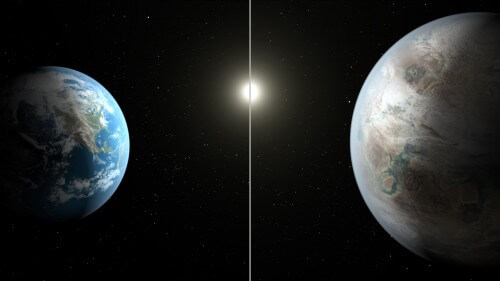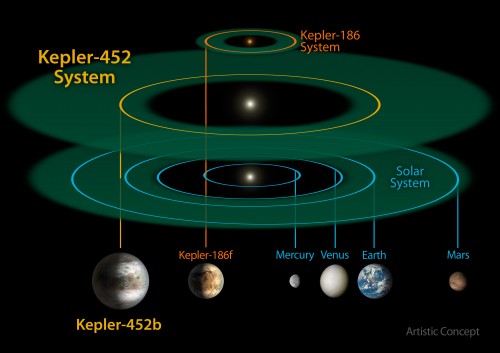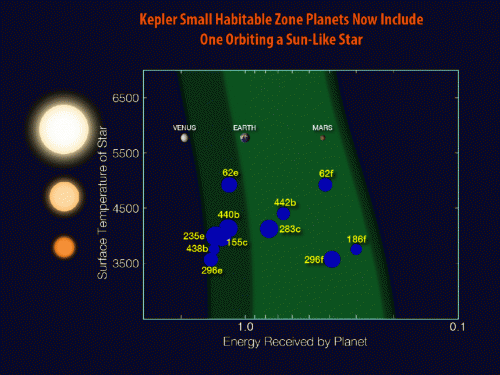 NASA says that this discovery and the discovery of 11 other new and small candidates in the habitable zones of their suns is a landmark towards the discovery of a second "Earth"
NASA says that this discovery and the discovery of 11 other new and small candidates in the habitable zones of their suns is a landmark towards the discovery of a second "Earth"
The Kepler space telescope has confirmed the first planet close in size to the asteroid and which is in the habitable zone around a Sun-like star. This discovery and the discovery of another 11 new and small candidates in the habitable zones of their suns is a landmark towards the discovery of a second "Earth".
The new planet, Kepler 452b is the smallest planet observed so far that orbits its sun in a habitable zone - a region where liquid water can accumulate on the surface around a G2 star - that is, similar to our sun. Confirmation of Kepler 452b brings the total number of planets discovered by Kepler and discoveries confirmed by repeated tests to 1,030.
In the 20th year since the discovery of the first planets outside the solar system, Kepler has discovered a planet and a star that most closely resemble Earth and the Sun," says John Grunsfeld, NASA's Assistant Administrator for Science Missions at NASA Headquarters in Washington. "These exciting results bring us another step closer to discovering Earth 2.0."
Kepler 452b is 60% larger than the Earth and is considered a "Super Earth". While its mass and composition are still unknown, previous studies lead scientists to conclude that there is a high probability that Kepler 452b is a rocky planet.
The length of the year of Kepler 452b is only 5% greater than ours = 385 days and it is also 5% farther from its sun than Earth is from the sun. Kepler 452, the star itself is 6 billion years old, meaning 1.5 billion years older than the Sun. It is about 20% brighter than the Sun and about 10% larger in diameter.

"We can think of Kepler 452b as a big, older cousin of Earth and it provides us with an opportunity to see how Earth will evolve," says John Jenkins, Kepler's chief data analyst at NASA's Ames Center in California, who led the Kepler discovery team. 452b. "The fact that the planet managed to survive six billion years in the habitable zone is inspiring. This is a longer period than the Earth. This gives an opportunity for life to arise, if all the ingredients and conditions necessary for life are present on the planet."
To help decipher the exact features of the Kepler 452 system, the team members used ground observations from several large observatories in the USA.
The Kepler 452 system is 1,400 light-years away in the direction of the Cygnus group. The research article appeared today in the "ASTRONOMICAL JOURNAL"
In addition to confirming Kepler 452b, Kepler team members announced an increase in the number of candidate planets to 521, from observations made by Kepler from May 2009 to May 2013, bringing the number of candidates discovered by Kepler to 4,696. In order to find out which of these observations does lead to a planet, follow-up observations and additional analyzes are needed to determine whether these are actual planets.
So far, Kepler observations have discovered 12 planets with a diameter 1-2 times that of Earth orbiting their suns in the habitable zone. Of these, at least nine suns are similar to our sun in size and temperatures. The current discovery is the closest in most features to Earth among them.

For a message on the NASA website
More on the subject on the science website

9 תגובות
Congratulations on discovering a new planet in the universe.
Has intelligent life been discovered on Earth?
Is humanity that has developed a technology that is going to destroy life really considered intelligent?
1. First time I hear this name "Ben David", is this the official name given to him at NASA? Or is it only here in Israel that they call him that?
2. They must already be after a nuclear holocaust and everything there is desolate and arid.
3. It's really depressing that because of the huge distances there is no chance that in our lifetime we will be able to go there and actually see with our own eyes what is going on there, all you can do is just throw out guesses.
4. Agrees with Theodore's questions.
OK, so there is a liquid environment, what about the atmosphere? Is it possible to land it [I got carried away, huh? ] ? What about priority for establishing computerized space stations in such places?
Amit
One of the roles of the European spacecraft (Venus Express) is to search for life - on Earth! The intention is to learn whether we are really able to detect life from a great distance. Remember that the distance to Venus is nothing compared to the distance to the planet Kepler discovered. We do not see the planet directly, but only its effect on the star it surrounds (oscillations, shadow, etc.).
We are not close to being able to recognize signs of culture at such distances.
1. How do scientists know that Kepler contains a life-supporting environment as we know it? See the case of Venus and Mars - two rocky stars that are in the "living zone" but one of them is a boiling hell and the other lacks a proper atmosphere and is bombarded with UV radiation.
2. Is it possible to perform spectroscopy tests on Kepler 452b and identify part of its composition?
A question for those in the know - does discovering the location of such a planet allow us to try and identify a specific civilization in its location? For example, to try and identify radio waves emanating specifically from the area where he is? Or artificial light emanating from the star... That is, instead of trying to detect signs of intelligent life everywhere, optimize the process and try to focus it in this area?
Thanks in advance!
Missing information about its distance from "Earth 1.0"
To my father, please update about the Soyuz spacecraft and three new members on it